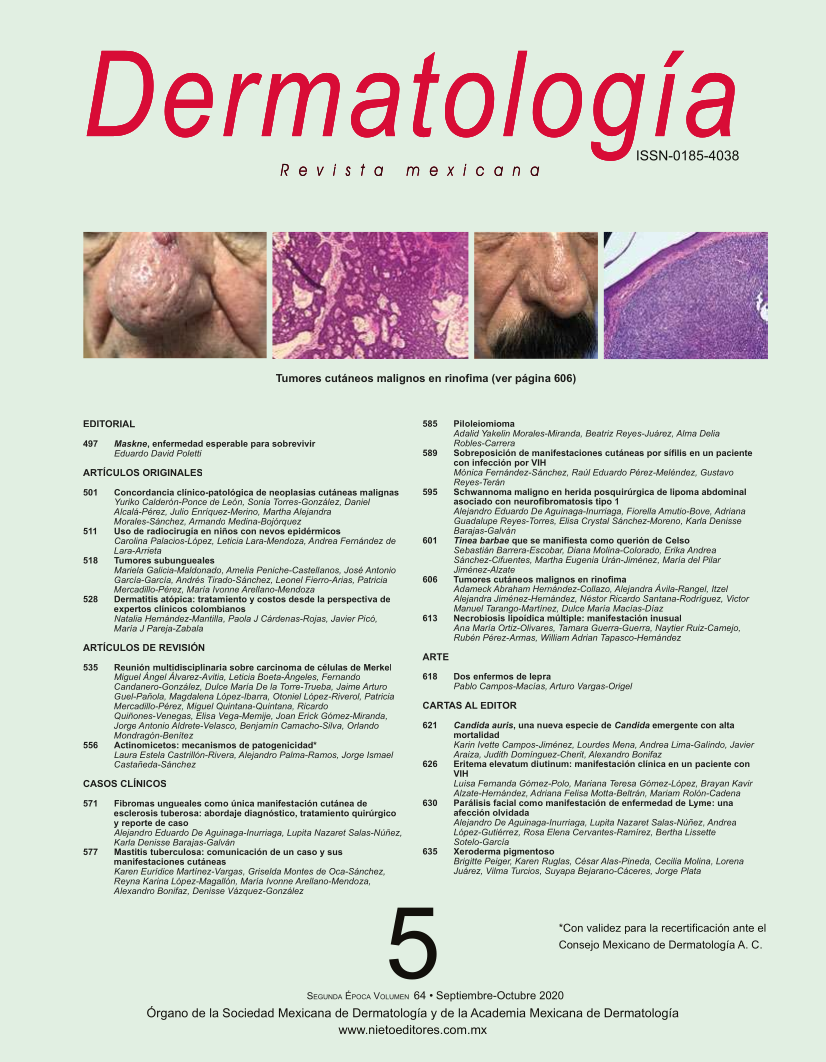Resumen
Antecedentes: la infección por virus del papiloma humano (VPH) es una de las enfermedades de trasmisión sexual más comunes; si bien los hombres en ocasiones sólo son portadores, pueden tener diversas manifestaciones clínicas y los condilomas acuminados son frecuentes en la consulta médica. Existen más de 200 tipos de VPH. Los tipos 6 y 11 se han aislado incluso en 90% de los condilomas acuminados; sin embargo, algunos estudios internacionales refieren haber detectado los tipos 16, 18, 31, 33 y 35 en 10% de estas lesiones. Objetivo: determinar, mediante la reacción en cadena de la polimerasa, los genotipos del VPH en condilomas acuminados de pacientes del sexo masculino atendidos en el Centro Dermatológico Pascua. Pacientes y método: estudio transversal, descriptivo y prospectivo en el que de septiembre de 2005 a junio de 2006 se tomaron biopsias de 48 pacientes con condilomas acuminados y se genotipificaron por el método PVHfast. Resultados: hubo un predominio de las lesiones localizadas en la región genital, con 29 casos (60.4%), sobre la localización anal, con 18 casos (37.5%). Los dos pacientes cuyas lesiones eran acentuadamente queratósicas y de mayor tamaño tenían diabetes mellitus tipo 2. Se detectó el VPH 68 (alto riesgo) en un paciente con coinfección por VIH. Sólo hubo tres pacientes con antecedentes de infección de trasmisión sexual. La distribución de los genotipos identificados coincide con la bibliografía internacional y se detectaron los genotipos 6 y 11. No se encontró asociación entre topografía, inmunosupresión ni evolución con el genotipo detectado. Conclusiones: se observó predominio del VPH 6 y 11; el 6 se encontró con mayor frecuencia. No se corroboró coinfección con varios genotipos. Palabras clave: virus del papiloma humano, genotipificación, condilomas acuminados, verrugas genitales, papiloma viral.
Palabras clave: papiloma viral., genotipificación, condilomas acuminados, virus del papiloma humano, verrugas genitales
Abstract
ABSTRACT Background: Infection with HPV (human papillomavirus) is the most common sexually transmitted disease, although sometimes men who are only carriers may exhibit different clinical presentations of genital warts being a frequent pathology medical consultation. There are over 200 types of HPV. Types 6 and 11 are isolated up to 90% of genital warts; however, some international studies have identified the types 16, 18, 31, 33 and 35 in 10% of genital warts. Objective: To determine by polymerase chain reaction HPV genotypes in genital warts of male patients at the Dermatology Center Pascua (CDP), Mexico City. Patients and method: A cross-sectional, descriptive and prospective study performed with biopsies of 48 patients with genital warts, and genotyped by the method PVHfast, from September 2005 to June 2006. Results: There was a predominance of lesions of genital region with 29 cases (60.4%) and anal location (n=18, 37.5%). The two patients whose lesions were markedly larger keratotic had diabetes mellitus type 2. HPV 68 (high risk) was detected in a patient suffering from HIV coinfection. Only 3 patients had a history of sexually transmitted infections. The distribution of genotypes identified consistent with the international literature, detecting the genotypes 6 and 11. No association was found among topography, immunosuppression or evolution with genotype detected. Conclusions: There was predominance of human papillomavirus 6 and 11; type 6 was found more frequently. There was not coinfection with several genotypes. Key words: human papillomavirus, genotyping, genital warts, HVP, viral papilloma.
Keywords: HVP, genotyping, human papillomavirus, viral papilloma., genital warts

